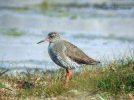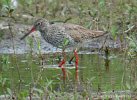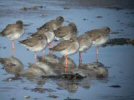Mangoverde :: World Bird Guide :: Sandpipers and Allies :: Common Redshank
Common Redshank Tringa totanus
Described by: Linnaeus (1758)
Alternate common name(s): Redshank
Old scientific name(s): None known by website authors
Photographs





Select thumbnail to view larger image - Place cursor over image for image information
Select additional thumbnail page to view 7 more images.
Range
Palearctic:
(1) Iceland, Faeroes and possibly Scotland.
Winters in the British Isles and w. Europe.
(2) N. Europe in the Orkney Is., Shetland Is. and n. Scandinavia s. through the British Isles and w. Europe (Biebrza Marsh, Poland, Senne, w. Slovakia, Iberian Peninsula and n. Italy), Tunisia and Turkey, Transcaucasus, Turkestan, then e. to w. Siberia.
Winters in the Mediterranean Basin s. to tropical Africa, w. India and Indosnesia.
(3) S. Siberia in Transbaicalia and Mongolia e. to n. Manchuria, Amurland, Ussuriland, Anadyrland and the Soviet Far East.
Winters in the e. Mediterranean region, Red Sea and e. Africa e. through Arabia and the Persian Gulf region and w. India and probably further e.
(4) S. Manchuria.
Winters in se. Asia and Taiwan.
(5) Nw. China (nw. Xinjiang).
Winters in unknown regions, but probably in e. China.
(6) C. Asia from Pamir Mountains to n. India and c. and s. Tibet.
Winters in India, China and Sulawesi.
Videos
No videos are available for this species
Sounds
 Location unknown - Date unknown Source: Massaciuccolis Oasis
Location unknown - Date unknown Source: Massaciuccolis Oasis
 Location unknown - Date unknown Source: ETI BioInformatics
Location unknown - Date unknown Source: ETI BioInformatics
References
Clements, James F. Birds of the World: A Checklist. Vista, CA: Ibis Publishing Company, 2000.
Comments/Errors
Please email with errors/comments on this page or to donate photos.
If there is no family list to the left, you may have arrived at this page from a direct link.
Please select "Mangoverde World Bird Guide" to view the entire bird site.









